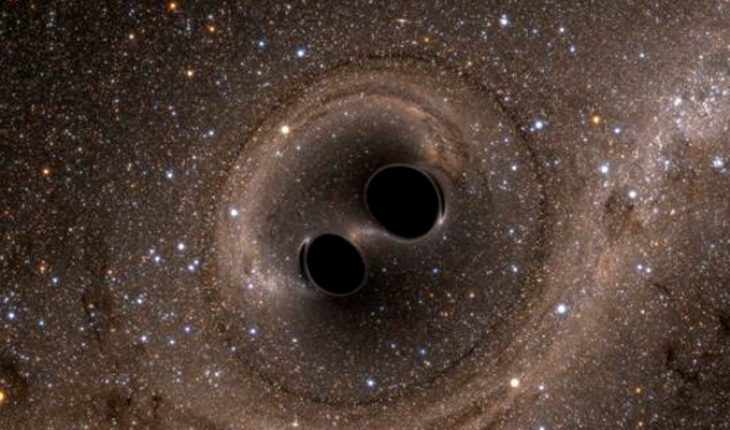Photography/ABC
World.- Seven billion years ago, at a distance of 17 billion light-years, two black holes, 66 and 85 solar masses, merged resulting in a massive new black hole, of about 142 solar masses. Both the two parent holes and the resulting fusion are located in a mass range higher than previously observed, and the resulting one is the most massive black hole ever detected with gravitational waves. The astrophysical community is baffled by discovery, which breaks with what was known about the origin of black holes.
“There is no standard scientific theory explaining the existence of this massive black hole,” certifies SINC Sascha Husa, a researcher at the Institute of Applied Computing & Community Code of the Universitat de les Illes Balears (UIB) and a member of the editorial team of the two articles published in the journals Physical Letters Review and Astrophysical Journal Letters, where the results obtained have just been released, as well as their scientific implications.
This finding, developed from a 0.1-second signal, has been the result of 15 months of work by two major scientific collaborations (Virgo in Italy and LIGO in the US) that have had hundreds of experts from various countries, including Spanish participation. The massive binary system has been dubbed GW190521 – as the gravitational wave event was perceived on May 21, 2019.
That the mass record detected by the Virgo and LIGO collaborations has been broken is an unprecedented discovery. “This detection opens the door to discovering many more possible new astrophysical effects,” advances Thomas Dent, coordinator of the gravitational wave program at the Galego Institute of High Energy Physics (IGFAE) and a member of the LIGO Scientific Collaboration.
A crucial aspect is that the remaining black hole is intermediate mass, and this relates to one of the most fascinating and complex puzzles of astrophysics and cosmology: the origin of supermassive black holes. These giant monsters, millions to billions more massive than the Sun and often in the center of galaxies, could arise from the fusion of smaller intermediate-mass black holes.
To date, very few candidates of this type have been identified only through electromagnetic observations and this is the first observation via gravitational waves. In addition, the range of 100 to 1,000 solar masses has for many years represented a ‘desert’ of black holes.
“Both the [agujero negro] 85 like the 66-year-old are much larger black holes than the intermediate star mass we knew. In the range between 60 and just over 100 times the mass of the Sun is not expected to form a black hole of stellar mass”, tells SINC the researcher Alicia Sintes, of the Universitat de les Illes Balears (UIB) and member of LIGO.
“Gravitational waves are discovering objects or events that we didn’t expect. There must be mechanisms that we do not understand and that allow the generation of black holes with higher solar masses, such as supernovae”, deduces Sintes.
On the one hand, there are supermassive black holes, with a mass ranging from hundreds of thousands to billions of times the mass of the Sun. This is the case of the black hole in the center of the Milky Way, with a mass about 4 million times that of the Sun. The way they were generated is still a mystery.
The astrophysical community did not expect to observe any black holes in a range between 60 and 120 solar masses
You may be interested: In February, first screening for face-to-face classes in Michoacán
On the other hand, the black holes of intermediate mass are located, whose masses range from 100 to 100,000 times the mass of the Sun. Its origin is vague. This is the case with the perceived remnant, the GW190521, which has originated from the merger of two other masses.
Finally, there are the black holes of stellar mass, whose mass is a few tens of times the solar mass. They are believed to have formed from the collapse of the nucleus of a massive star, using supernova explosions.
One of the great mysteries of the new find is the origin of the two parent black holes. “If they arose from the collapse of stars, they are placed in a mass range in which their presence is considered, in theory, impossible,” Dent explains. “Therefore, it could help improve our understanding of the final stages of the life of massive stars,” hestes. If they can know and understand it, they could find out what the ori issupermassive black hole gene, one of the most complex puzzles of astrophysics and cosmology.
It is known that black holes with masses between 65 and 120 times the mass of the Sun cannot have been formed after the collapse of a star. Through a phenomenon known as “pair instability”, when the stars explode with these masses, they leave behind only a cloud of gas and cosmic dust, ‘making it impossible’ to form black holes of these dimensions.
Therefore, the astrophysical community would not expect to observe any black holes in this range of solar masses, between about 60 and 120. That is exactly the mass range in which the most massive component of GW190521 (66 and 85 solar masses) is located.
Clearly, more observations of holes of this type are needed to understand exactly what has happened and how phenoonemos like the one described are explained. At the moment, there are already some hypotheses among the scientific community.
“There are two natural explanations: one is that this scientific theory is not correct, because these phenomena are more complicated than previously thought, and the other is that these black holes have in turn been formed by the fusion of smaller ones. Of course, it’s not very likely that two holes will be found, unless they were found in a stellar cloud and the fusion occurred in a high-density area of stars,” Husa suggests as possible explanations.
Source: SINC
translated from Spanish: The merger of two black holes baffles the astrophysical community
September 6, 2020 |





